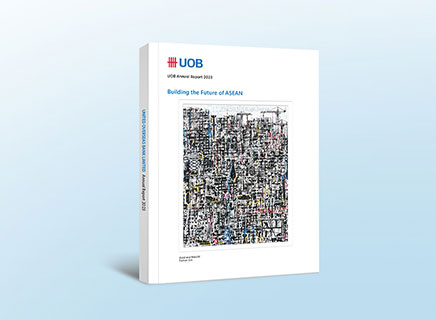Explore ASEAN's FinTech evolution over the past decade, driving digital innovation and inclusion across the region.
Global FinTech funding experienced a decline as high interest rates and uncertain macroeconomic conditions persisted in 2023.
Echoing this trend, investments into ASEAN’s FinTech firms in the first three quarters of 2023 have plunged to their lowest (US$44 billion) since 2020, following five quarters of decline.
An area that is garnering significant investor interest is sustainability, and by extension, Green FinTech. As the industrial world prepares for a climate transition, many businesses are missing reliable, accurate data about their value chains, impeding how they measure, report and reduce their total carbon emissions. This is where Green FinTech comes in.
In our FinTech in ASEAN 2023: Seeding the Green Transition report, we find out what some companies are doing in the race for a cleaner, greener future.

Down but not out: FinTechs ride funding slump
In 2022, FinTech firms in ASEAN-6 (Indonesia, Malaysia, the Philippines, Singapore, Thailand and Vietnam) remained attractive despite external pressures, clocking US$5.1B led by late stage deals.
This year, investments into ASEAN FinTech declined sharply by 75 per cent vs FY2022, hitting US$1.3 billion, the region’s lowest since 2020.


Singapore and Indonesia continue to lead FinTech investments in region
While the Philippines saw a reduction in its share of the funding pie with no mega deals in YTD 2023, Singapore and Indonesia accounted for more than 86 per cent of total FinTech funding in the region.
Alternative lending and insurtech lead funding numbers
For the first time, alternative lending firms raised the most funding, receiving almost a third of total ASEAN-6 investments with US$408 million. Both alternative lending and insurtech firms buck the decline in funding for YTD 2023 by exceeding their total funding amounts for 2022, in part due to the mega deals led by Kredivo, Bolttech and Advance Intelligence Group.
Cryptocurrency firms struck the most deals, but at smaller deal sizes
The cryptocurrencies category remains attractive, with the highest number of deals. However, its share of the funding amount declined by 10 percentage points, as investors steer clear of overvaluation in the sector.
Carbon conundrum: FinTechs rise to meet green demand
Sustainability—and the transition to a low-carbon economy—has become a growing priority in recent years, as pressure mounts on industries to cut back on carbon emissions that cause global warming.
As regulators extend climate reporting requirements to more companies along the global value chain, businesses—and their upstream and downstream network—are considering how to accurately measure and track their carbon emissions. The most common framework used is the Greenhouse Gas Protocol (GHG Protocol).

Calculating carbon emissions: What are Scopes 1, 2 and 3?
GHG emissions are categorised into Scope 1 (direct emissions from company facilities and company vehicles), Scope 2 (indirect emissions from purchased energy), and Scope 3 (indirect emissions from upstream and downstream activities).
The scopes denote the different kinds of GHG emissions a company generates, whether in the company’s own operations or within the firm’s wider value chain, the latter contributing up to 90 per cent of a company’s emissions.
Enter the Green FinTechs
Green FinTechs are companies that use innovative technologies to enable financial processes and products, delivering environmental benefits and contributing to a net zero economy. They can help organisations meet the need for quality, regulatory-approved sustainability reports that are reliable and transparent on aspects like carbon data.
Green FinTech companies can be categorised by the services offered, for example data analytics, data collection, carbon services, infrastructure, reporting and RegTech.
Sustainability transition roadmap
As businesses embark on their green journey, the sustainability transition roadmap is useful in charting a company’s general approach. Comprising five phases, the roadmap lays out how the different types of Green FinTechs can play a role in each phase to enable green transformation.
SMEs that are considering sustainability but need guidance can also try the UOB Sustainability Compass, an online tool that generates a customised report based on the company’s sector and sustainability maturity stage.

Looking ahead: What’s next for FinTech?
While the decline in FinTech funding has coincided with a similar downward trajectory for the tech sector, certain trends have suggested that recovery is on the horizon. Some of these include the accelerated digitalisation of traditional industries in emerging markets, along with the rapid advancement in artificial intelligence (AI) – for example, generative AI applications in FinTech – that can help reshape FinTech innovations.
Navigating the green horizon
In the space of Green FinTechs and the businesses they work with, achieving green goals remains a bumpy journey and a work-in-progress – albeit one that continues to unearth gaps and opportunities for companies to provide solutions. There is neither a one-size-fits-all technology that can halt environmental threats immediately, nor are there specific regulations that can be laid down right away to alleviate climate issues. What is certain, is that FinTech and GreenTech can work together to create impact, in tangible and meaningful ways.
Seeding the green transition
Businesses are now recognising that green practices are not merely a moral imperative but also a strategic advantage, enabling them to mitigate risks and capitalise on emerging opportunities.
To that, businesses in ASEAN should consider going green as an integral part of their operational strategies, aligning with international best practices and the evolving regulatory environment. By embracing green development, companies can not only safeguard their long-term viability but also contribute to a more environmentally responsible future for ASEAN and the world.
Explore other reports

FinTech in ASEAN 2024: A Decade of Innovation

FinTech in ASEAN 2023: Seeding the Green Transition
In the wake of a global shift towards a low-carbon economy, opportunities abound in the Green FinTech space.

FinTech in ASEAN 2022: Finance, Reimagined
ASEAN’s FinTech firms received US$4.3B in funding in the first three quarters of 2022. As digital services continue to proliferate, we explore the rise of embedded finance in ASEAN.








